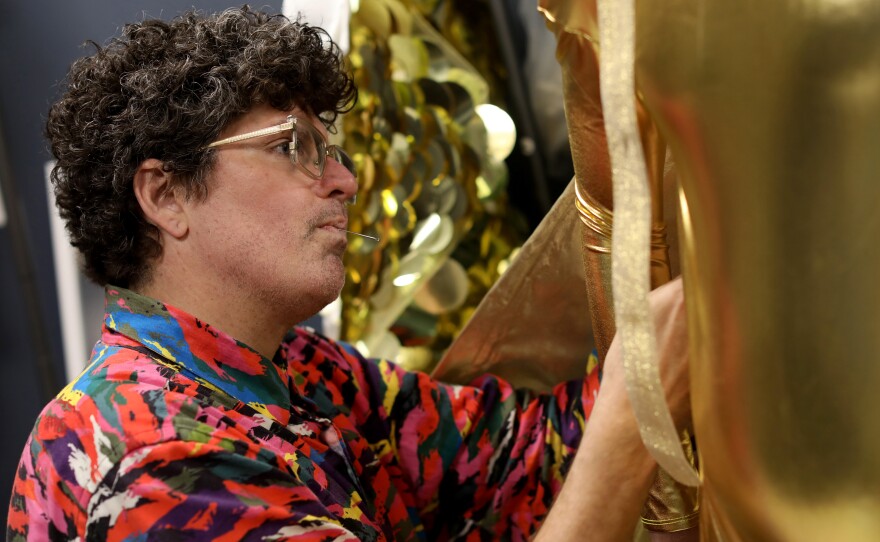This week, an opera was born. But the birth of Jean-Philippe Rameau's Io has been a long time coming — in fact, it took about 280 years.
"We don't know anything about this opera, not the name of the librettist, nor the theater for which it was intended, nor the date of composition and why Rameau has not completed this opera," says French musicologist Sylvie Bouissou.
The longtime Rameau expert recently completed the 18th century French composer's unfinished manuscript of Io, which received its world premiere at the Kennedy Center in Washington, D.C., this week, with an additional performance at New York's El Museo del Barrio next week.
"To try to complete the work and give it a possible life at last after almost three hundred years, it was quite a challenge, believe me," Bouissou tells Morning Edition host Leila Fadel. "I hope the American public feels that because ... it's a gift, really."
As it turns out, Io is a hilarious one-act opera-ballet. The plot pits two gods fighting for the love of a mortal nymph, the titular Io. Mercury plays his traditional role of messenger. There's a storm, a character representing madness ("la Folie") and the two gods just might have something going for each other.


If this sounds frivolous and over the top, that's because it is. The opera has its roots in Rococo, a dramatic and lavish style that emerged in the arts of late 18th century France. This late Baroque period was part of the last hurrah of the monarchy, before it all came crashing down with the French Revolution of 1789 – the one that beheaded a king and queen.
Opera Lafayette's production features an international cast of five lead characters, six Seán Curran Company dancers and 16 chorus members with a chamber orchestra of Baroque period instruments. The Washington, D.C.-based group interprets and produces opera from the 17th to 19th centuries.


Maximalist costumes
"It truly is a maximalist aesthetic," says costume designer Matthew Flower, who goes by Machine Dazzle. His oversized outfits burst with color and texture. There are hints of drag and burlesque, with sequins, glitter and found objects.
"Everything was just like, look at all of those layers of the dress, look at all of that hair, look at all of the flowers in the hair," he tells NPR's Leila Fadel. "Everything is abundance and alive and beautiful and lush. And everything is like a dessert that has 20 layers."
Rococo was a natural fit for Dazzle, who describes himself as an "instinct-based, emotionally-driven, conceptual artist trapped in the role of costume designer most of the time." The designer's star is on the rise after his first retrospective show, which closed in February at the Museum of Arts and Design in New York.
A cascading rainbow of tulle fabric with satin backing wraps Folie, whose head is framed in yellow and green like a peacock train. She stands 12 to 14 feet tall, and her skirt has a 20-foot radius when spread out flat on the floor. Multicolored Graces — goddesses of beauty, grace and charm — dance at her feet. At one point, dancers storm in wearing three large "tornadoes" above their heads.
Apollo's fish-laden disguise as a mortal is a tongue-in-cheek nod to Madame de Pompadour, the onetime official chief mistress of King Louis XV and influential patron of the arts. She was born Jeanne-Antoinette Poisson (fish). Today, she lives on in the dramatic, upswept hairstyle that bears her name.


An 18th century opera relevant to a 21st century audience
Opera-goers may find some similarities with Platée, another Rameau comic opera first performed in 1745 at the royal palace of Versailles. Bouissou found numerous clues that suggest Io preceded Platée and may have even served as a draft for the longer opera.
Dazzle's costumes help bring the opera into the 21st century, turning the production into something modern and edgy — and more palatable to a contemporary audience.
"It's important to make it more current," he says. "You can do that through adding little playful things. I didn't want to create old historical-looking costumes."
For opening night, Dazzle plans to sit in the back row to watch the public react to the culmination of months of long days and sleepless nights.
It's also a landmark moment for Bouissou.
"I was excited with this experience, because it's wonderful, finally it's a rebirth. And with this type of experience and other productions in the world, I know why I do this difficult job — serving Rameau, an absolute genius," she says.
Chad Campbell produced the audio version of this story. contributed to this story
Copyright 2023 NPR. To see more, visit https://www.npr.org. 9(MDAzMjM2NDYzMDEyMzc1Njk5NjAxNzY3OQ001))







